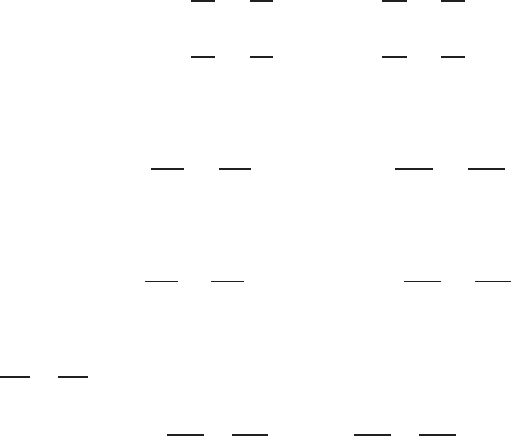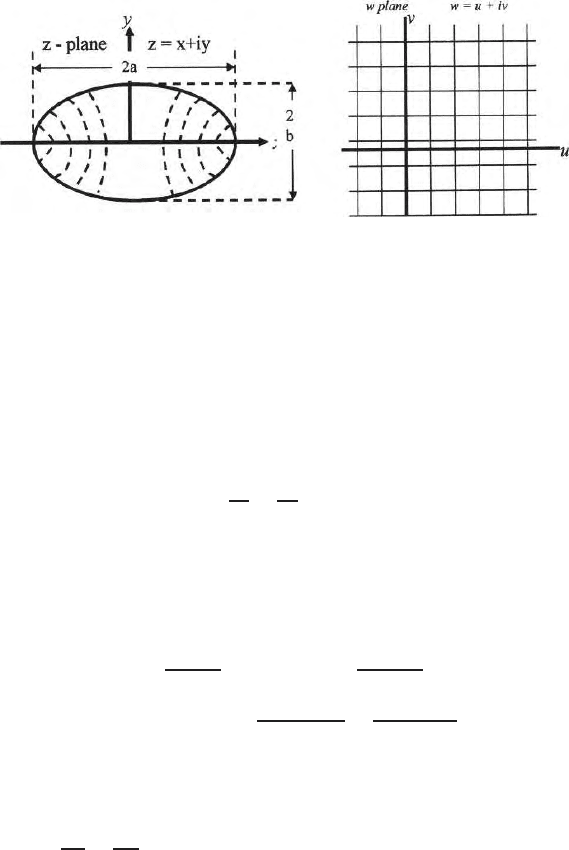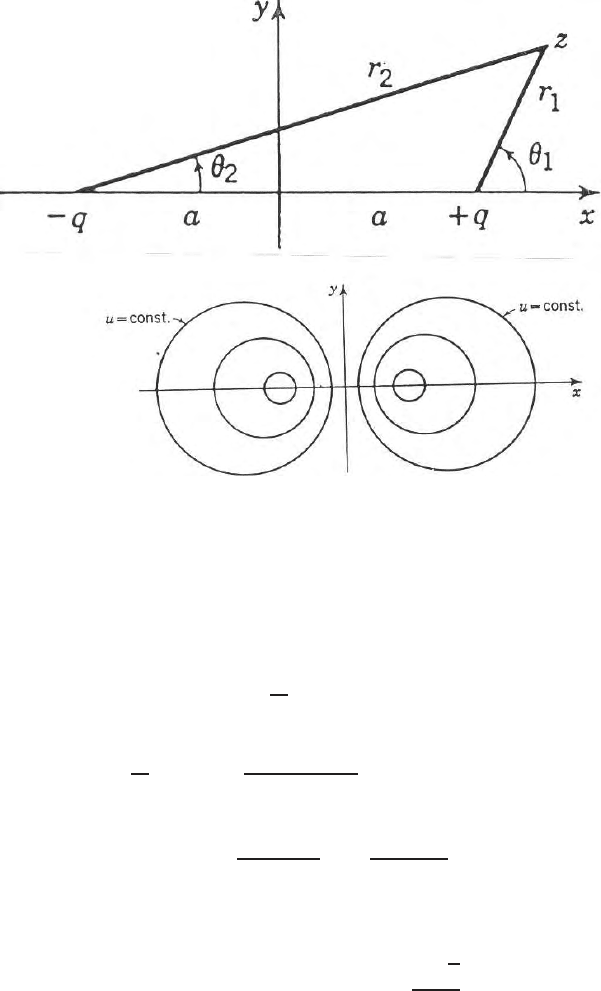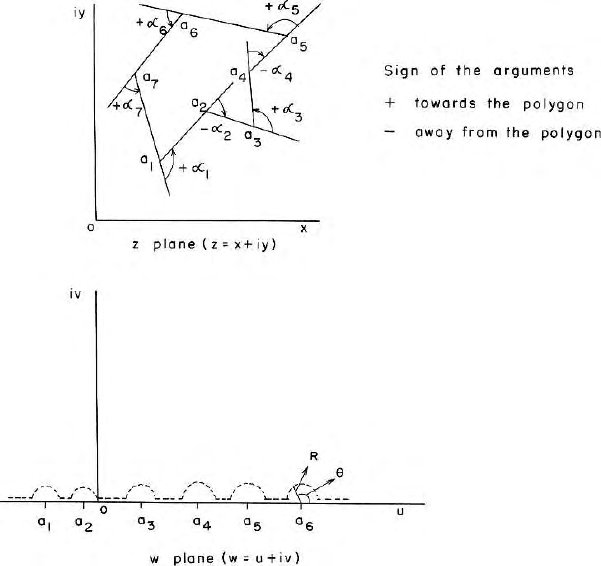Roy K.K. Potential theory in applied geophysics
Подождите немного. Документ загружается.


9.4 Transformations 269
By adding and substracting (9.26) and (9.27) and using 9.22 we obtain
∂
∂x
+ i
∂
∂y
= f
′
(z)
∂
∂u
+ i
∂
∂ν
(9.28)
∂
∂x
− i
∂
∂y
= f
′
(z)
∂
∂u
− i
∂
∂ν
. (9.29)
Hence from (9.28) and (9.29) is get
∂
2
∂x
2
+ i
∂
2
∂y
2
u = |f
′
(z)|
2
∂
2
U
∂u
2
+ i
∂
2
U
∂ν
2
. (9.30)
From (9.30) we get
∂
2
u
∂x
2
+i
∂
2
u
∂y
2
=0=|f
′
(z)|
2
∂
2
U
∂u
2
+i
∂
2
U
∂ν
2
. (9.31)
Since f
′
(z) =0,
∂
2
U
∂u
2
+
∂
2
V
∂ν
2
= 0 and from (9.14) it can be shown that
∂
2
U
∂x
2
+
∂
2
U
∂y
2
=0and
∂
2
V
∂x
2
+
∂
2
V
∂y
2
=0. (9.32)
Hence both U(u, ν)andV(u, ν) will satisfy Laplace’s equation. This is an alter-
native approach to prove that analytic functions in two-dimensional medium
in a complex plane satisfy Laplace equations.
9.4 Transformations
The set of equations
u=u(x, y)
ν =v(x, y) (9.33)
defines in general a transformation or mapping which establishes a corre-
spondence between points in the uν and xy planes. These (9.32) are called
transformation equations. If to each point of the uv plane there corresponds
one and only one point in the xy plane and conversely, we speak of one to one
transformation or mapping, in such a case a set of points in the xy plane is
mapped onto a set of points in the uv plane. The corresponding set of points is
often called images of each other. When u and v are real and imaginary parts
of an analytical function, a complex variable w = u + iv = f (z) = f (x + iy)
and the transformation will be one to one in the region where f
′
(z) =0.

270 9 Complex Variables and Conformal Transformation in Poten tial Theory
A mapping in the plane is said to be angle preserving or conformal if
it preserves angle between oriented curves in ma gnitude as well as in sense
i.e., the image of any two intersecting oriented curves taken with their corre-
sponding orientation make the same angle of intersection with the curve both
in magnitude and direction.
Corollary 1 – If f (z) is analytic and f
′
(z) = 0 in a region R, then the
mapping w = f (z) is conformal at all points of R.
Corollary 2 – The mapping defined by an analytic function f (z) is conformal
except a points where the derivative f
′
(z) is zero.
9.4.1 Simple Transformations
In this section we choose two simple mathematical relations in a complex
domain to demonstrate that these relations can show the nature of field lines
and equipotential lines in a two dimensional problem..
Problem 1
In this problem, we chose a simple transformation z = k coshw (Pipes 1953)
and show how orthogonal current lines and equip otential lines in a square grid
in w(= u + iv) plane transforms to ellipses and hyperbolas in the z(= x + iy)
plane to represent equipotential lines and current lines for a finite line source.
Let
z = k cosh w = k cosh(u + iv) (9.34)
where k is a real constant. (Fig. 9.5 a,b) To study this transformation, we
must determine the curve u = const and v = const. Expanding cosh(u + iv)
into its real and imaginary parts, we obtain
x + iy = k(cosh u cos v + i sinh u sin v) (9.35)
x = k cosh u cos v (9.36)
y=ksinhusinv
Thismaybewrittenintheform
cos v =
x
kcoshu
(9.37)
sin v =
y
ksinhu
Therefore, on squaring th ese equations and adding them, we have
x
2
k
2
cosh
2
u
+
y
2
k
2
sinh
2
u
=1. (9.38)

9.4 Transformations 271
Fig. 9.5 a,b. Simple cosine hyperbolic transformation changes ellipse and hyperbola
inthezplanetosquaregridinthew–plane
If we put
a = k cosh u (9.39)
b=k sinh u,
the (9.38) can b e written as
x
2
a
2
+
y
2
b
2
=1. (9.40)
This is the equation of an ellipse with its centre is at the origin and having a
major a xis of length 2a and a minor axis of length 2b. Hence the curve u =
constant are a family of confocal ellipses.
To obtain the curve u = constant, we write in the form
cos h u =
x
kcosu
andsinhu=
y
ksinν
(9.41)
cos h
2
u −sinh
2
u=
x
2
k
2
cos
2
u
−
y
2
k
2
sin
2
ν
=1. (9.42)
If we set a
′
=k cos ν and b
′
=k sin ν,
we have
x
2
a
′
2
−
y
2
b
′
2
=1. This is an equation of a hyperbola. (9.43)
For a direct current flow field the equipotential lines are elliptica l and field
lines and current flow lines are hyperbolic due to a line source of finite length.
Case 2
Problem 2
A simple transformation of a line source and a sink in a z plane maps the field
lines and equipotential lines in a w-plane.

272 9 Complex Variables and Conformal Transformation in Poten tial Theory
Let
w=Aln
z −a
z+a
. (9.44)
We have seen that the equation
w=−
q
2πk
ln z = u + iν (9.45)
gives the appropriate transformation to study the electric field in the region
surrounding a charged circu l ar cylinder with its centre at the origin and having
a charge Q per unit length (Fig. 9.6a and b). In this case the real part of the
transformation is
u=−
q
2πk
ln r and the imaginary part is
ν =
−q
2πk
ln θ. (9.46)
Let us now consider a field pro du ced by a line charge of +q per unit length
at z = a and another line charge of −q per unit length at z = − a. The fields
produced by both the line charges gets added up and is given by
w=+
q
2πk
ln (z −a) −ln (z + a) = −
q
2πk
ln
z −a
z+a
. (9.47)
Equation (9.47) represents the proper transformation to determine the field
and equipotentials of two line charges.
Let
A=−
q
2πk
, (9.48)
we then have
u+iν =Aln
z −a
z+a
. (9.49)
If we now let the distance of the point P (Fig. 9.6 a,b) from the point z = a
and z = −aber
1
and r
2
respectively, we have
z −a=r
1
e
iθ
1
(9.50)
z+a=r
2
e
iθ
2
(9.51)
where θ
1
=arg(z− a) and θ
2
= arg(z + a).
Hence u + iν = A [ln (z − a) − ln (z + a)]
= A [ln r
1
+ iθ
1
− ln r
2
− iθ
2
] . (9.52)
Therefore,
u=Aln
r
1
r
2
(9.53)

9.4 Transformations 273
Fig. 9.6 a,b. Simple logarithmic transformation simulates the fields and equipo-
tentials for a line source and a sink
and
ν =A(θ
1
− θ
2
). (9.54)
These are the curves for u = constant and ν = constant.
If we put
ln
r
1
r
2
=u/A (9.55)
then
r
1
r
2
=e
u/A
=
(x − a)
2
+y
2
(x + a)
2
+y
2
=e
2u/k
= K (9.56)
Therefore
y
2
+
x −
a (1 + K)
(1 −K)
2
=
4a
2
K
(1 −K)
2
. (9.57)
We thus see that the curves u = constant are a family of circles with eccentric
gradual shifting of centres along the line joining the source and sink.
x=a(1+k)/ (1 − k) and r =
2a
√
k
1 −k
(9.58)
These eccentric circles are the equipotentials d ue to a line source and a line
sink in a homogeneous and isotropic medium.

274 9 Complex Variables and Conformal Transformation in Poten tial Theory
9.5 Schwarz Christoffel Transformation
9.5.1 Introduction
Schwarz and Christoffel independently proposed that a suitable transforma-
tion function or mapping function can be determined for transferring the
problem in the z plane to the w plane such that the problem is solved in the
w plane and at the end we can return back to the z-plane again and present
the final answer. In case it is necessary one may have to go for successive
transformation depending upon the nature of the problem. As for example in
certain cases one may have to go from w plane to t plane ,from t plane to
t’ plane, get the solution in the t’ plane and finally come back to z plane to
present the final answer.
9.5.2 Schwarz-Christoffel Transformation of the Interior
of a Polygon
The problem to find a mapping function to map the interior of a n-sided poly-
gon in the z-plane onto the upper half of the w-plane such that the boundary
of the p olygon goes over to the real axis of the w-plane. The upper half of
the w-plane goes to inside of a polygon. Let w = a
1
, a
2
, a
3
,......a
n
be images
on the real axis of the vertices of a polygon z = z
1
, z
2
, z
3
,......z
n
.Weshall
assume that a
1
< a
2
< a
3
.......a
n
(Fig. 9.7 a,b). The mapping function
should be such that (i) A segment of real axis of the w-plane boun ded by two
images of the vertices say, a
k
, a
k+1
must go over the corresp onding sides of
the polygon joining the points z
k
and z
k+1
.
This requires that the argument of the mapping function
dz
dw
=f
′
(w) must
remain constant for a
k
< w < a
k+1
.
(ii) As we cross an image of the vertices, say a
k+1
, the argument of the
mapping function must change discontinuously by an amount equal to the
exterior angle of the polygon at z = z
k+1
say θ = πα
k+1
(−1 < α
k+1
< 1)
such that
n
4
k=1
α
k
=2where(−1 < α
k
< 1). Note that w = a
1
, a
2
, a
3
,......a
n
must be br anch points of the mapping function because at these points the
angle between the tangents of the real axis do es not r emain constant during
transformation.
(iii) The upper half of the w-plane and the interior must have one to one
relation. Considering the mapping function of the following from
dz
dw
=A(w− a
1
)
−α
1
(w −a
2
)
−α
2
(w −a
3
)
−α
3
............(w −a
n
)
−α
n
,
(9.59)
The argument of f
′
(w) will be given by
Arg f
′
(w) = Arg A−α
1
Arg(w−a
1
)−α
2
Arg(w−a
2
) .........α
n
Arg(w−a
n
)
(9.60)

9.5 Schw arz Christoffel Transformation 275
Fig. 9.7 a,b. Show the conformal transformation of a complex geometry of a poly-
gon on to the real axis of the w-plane
Thus the net change in the argument is πα
1
. The argument remains con-
stant while a
1
< w < a
2
, but as we cross a
2
there is a further increase in the
argument by πa
2
. Thus there is an increase in the argument of f
′
(z) at each
of the image vertices by an amount equal to say πα
k
at the kth vertice. Total
increase in the argument after crossing a
n
is
n
k=1
πα
k
=2π = Arg A (9.61)
Since the argument of f
′
(w) remains constant for any interval on the real
axis of the w-plane, that interval should be mapped onto a side of the polygon.
For examples, the interval (a
k+1
− a
k
)mustbemappedontothekthsideof
length 1
k
. This gives us n relations.
1
k
= |A|
a
k+1
a
k
f
′
w
w
dw
w
k+1
w
k
(k = 1, 2, 3,...n) (9.62)

276 9 Complex Variables and Conformal Transformation in Poten tial Theory
These n equations are used in determining n unknown quantities a
1
, a
2
,
a
3
......a
n
images of the vertices of the polygon.
The mapping function f (z) is analytic in the upper half plane and the real
axis except at the images of the vertices a
1
, a
2
, a
3
........a
n
.Thesepointsare
branch points in mapping the real axis of the w-plane. We shall have to avoid
these branch points by following an infinitesimally small semicircle with the
centre at these branch points.
9.5.3 Determination of Unknown Constants
Integration (9.58), the mapping function may b e written as follows
Z=A
w
w
0
(w − a
1
)
−α
1
(w − a
2
)
−α
2
.........(w − a
n
)
−α
n
dw. (9.63)
Hence the n + 2 unknowns are A, w
0
, a
1
, a
2
,........a
n
.α
1
, α
2
, α
3
, α
n
are eas-
ily given by external angles of polygon. Hence we do not consider them as
unknowns. These constants can be determined applying suitable boundary
conditions as demonstrated in different problems presented in this chapter.
9.5.4 S-C Transformation Theorem
This is one o f the most powerful transformation techniques in a complex
domain. It transforms the interior of a polygon in the z-plane on to the upper
half of another plane, say the w
1
plane, in such a man n er that the side of a
polygon in the z-plane are transformed to the real axis of the w-plane. (Fig. 9.7
a,b) Schwar z and Christoffel independently have shown that gi ven the required
polygon, a certain differential equation may be written which when integrated
gives directly the desired transformation. Consider the expression
dz
dw
=A(w− a
1
)
φ
1
(w − a
2
)
φ
2
.........(w − a
n
)
φ
n
(9.64)
where A is a complex constant; a
1
, a
2
,......a
n
and φ
1
, φ
2
,......φ
n
are real
numbers and their arguments. Since the argument of a product of a complex
number is equal to sum of the individual factors, we have
dz
dw
=argA+φ
1
arg (w −a
1
)+φ
2
arg (w −a
2
) (9.65)
+ ......+ φ
n
arg(w − a
n
).
The real numbers a
1
, a
2
,......a
n
are plotted on the real axis of the w-plane
(Fig. 9.7b). If w is a real number then the argument of N
r
=w− a
r
is
arg (w −a
r
)=
0ifw> a
r
π if w < a
r
. (9.66)

9.5 Schw arz Christoffel Transformation 277
Let us suppose that the w traverses the real axis of the w-plane from left to
right. Then (w − a
r
) will be positive if w is greater than a
r
and it will be
negative when w is less than a
r
.
Let θ
r
=arg
dz
dw
when a
r
< w < a
r+1
.
We obtain
θ
r
=argA+(φ
r+1
+ φ
r+2
+ ........+ φ
n
)π
θ
r+1
=argA+(φ
r+2
+ φ
r+3
+ ........+ φ
n
)π. (9.67)
Hence
θ
r+1
− θ
r
= −πφ
r+1
Now
arg
dz
dw
=arg
dx + i dy
du
=tan
−1
dy
dx
. (9.68)
We see that this is the angle the element dz in the z-plane rotates into the
mapping of dw in the w plane by the S–C transformation. As we move along
the sides of the polygon in the z-plane, the corresponding movement in the
w-plane for one to one corresp ondence will be along the real axis.
When the point w passes from the left of a
r+1
to the righ t of a
r+1
in the
w-plane, the direction of the point z in the z-plane is suddenly changed by an
angle of – πφ
r+1
measured mathematically in the positive sense. If we imagine
the broken line to form the closed polygon then the angle α
r+1
measured
between the two adjacent sides of the polygon is called an interior angle.
We, then have
α
r+1
− πφ
r+1
= π (9.69)
Hence
φ
r+1
=
α
r+1
π
− 1. (9.70)
Substituting these values, we have
dz
dw
=A(w− a
1
)
α
1
π
−1
(w − a
2
)
α
2
π
−1
(w − a
3
)
α
3
π
−1
=A
r=n
Π
r=1
(w − a
r
)
α
r
π
−1
. (9.71)
Integrating the expression with respect to w, we have
z=A
n
Π
r=1
(w − a
r
)
α
r
π
−1
dw + B (9.72)
where B is an arbitrary constant. This transformation transforms the real axis
of the w-plane onto a polygon in the z-plane. The angles α
r
are the interior
angle of the polygon. The modulus of the constant A determines the size of
the p olygon and the argument of the constant A determines the orientation
of the polygon. The constant B determines the location of the polygon.

278 9 Complex Variables and Conformal Transformation in Poten tial Theory
9.6 Geophysical Problems on S-C Transformation
Two dimensional boundary value problems, which satisfy Laplace equation,
are presented in this section with considera b le details for only four problems.
These four problems can be classified in three categ ories i.e., (i) problems
where closed form solutions are available (ii) problems where closed form
solutions are not possible and numerical integration was required for its solu-
tion (ii i ) problems where closed form solutions can be obtained using elliptic
integrals and elliptic functions.
9.6.1 Problem 1 Conformal Transformation for a Substratum
of Finite Thickness
In this problem two plane parallel boundaries are assumed. The region in
between those boundaries constitutes the interior of a polygon with one angle
only as we move from one point of the polygon to the other. This region is
assumed to have a finite resistivity. Resistivities outside are infinitely high. In
geophysical model simulation resistivity of the crystalline basement is assumed
to be infinitely high in comparison to sediments of finite resistivity and thick-
ness. Above the air earth boundary, resistivity of the air is infinitely high
(Roy 1967).
Figure 9.8 a,b show the geometry of the problem in the Z plane and its
transformation on the real axis of the w plane. Here the thickness and resistiv-
ity of the top layer is ‘h’ and ‘ρ’ resp ectively. The point source of current I is
located at (0, h). For every problems we have to fix the origin on the z-plane.
Here the origin is fixed at a depth ‘h’ from the surface and on top of the
basement. Now the boundary conditions are dv/ dy = 0 at y = 0 and h. The
Schwarz Christoffel method of conformal transformation, for transforming the
geometry of the z-plane on to the real axis of the w-plane are bounded by the
following equation
dz
dw
=A(w− a)
−α/π
(w − b )
−β/π
(w − c)
−γ/π
(w −d)
−δ/π
(9.73)
where ‘a’, ‘b’, ‘c’, ‘d’ are the values of w at the corners of the polygon and ‘A’
is a constant as discussed. As we move from A to C, we cross the corner BB
′
only as there are no other corners. Hence the (9.73) reduces to the form
dz
dw
=A(w− a)
−α/π
. (9.74)
NowaswemoveacrossBB
′
, our movement has turned through an angle
of 180
0
or π because we started moving in the opposite direction. Therefore
α = π. Since we move towards the polygon (shown by the dotted lines) the
sign of the argument ‘α’ will be + or positive. Therefore (9.74) reduce, to the
form
